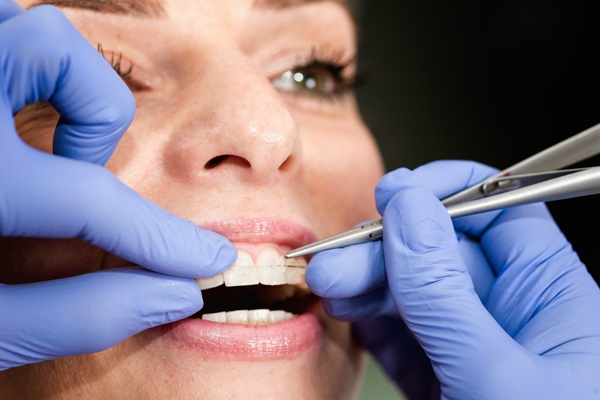 Thin, tooth-colored shells called veneers can be attached to the front of individual teeth to cover up imperfections or cracks. Used for both oral health and cosmetic purposes, patients often opt for this form of restoration to vastly improve a smile. Some people wonder if the shells can go a step further and also help a receding gumline. Here is a breakdown of receding gums and what these dental restorations can do for your smile.
Thin, tooth-colored shells called veneers can be attached to the front of individual teeth to cover up imperfections or cracks. Used for both oral health and cosmetic purposes, patients often opt for this form of restoration to vastly improve a smile. Some people wonder if the shells can go a step further and also help a receding gumline. Here is a breakdown of receding gums and what these dental restorations can do for your smile.
Understanding gum recession
Gums may recede from teeth for a variety of different reasons. Gum disease, injuries, teeth grinding, and simply age can cause gum recession. Unfortunately, gums that have receded never grow back, revealing parts of teeth that normally are not seen in a smile. Recession can also cause problems with oversensitivity if the root of a tooth is exposed. Patients with receded gums can feel uncomfortable smiling for a photo or have difficulties eating, so getting the issue resolved to restore confidence and health is always a priority.
Finding easy solutions
A patient suffering from gum recession usually has two options for fixing a smile. The first involves grafting tissue taken from the roof of the mouth to the receded gums, a procedure that fills in the exposed surface of a tooth. The second solution is the application of veneers over the exposed section. Because it is less invasive, getting the artificial restorations is a popular choice.
However, not everyone can choose them, as some patients have severely receded gums that require surgery to fix. Speak to a dentist about restoration options and to see if extra steps, such as gum treatment or antibiotics, are necessary. Once a patient has the all-clear, the veneers can be placed following these steps.
Choosing the right material
First, patients must choose between porcelain and composite resin restorations. Each has its advantages. Porcelain is more durable, lasts longer, and is less likely to break, but if damage does occur, the entire veneer must be replaced. Composite material does not have the same longevity due to limited durability, but it can be easily repaired if chipped or cracked. Patients who do not know which to pick can ask for advice from a dentist.
Receiving restoration treatment
During the appointment, the surface of the tooth is roughened to make adhesion stronger between the tooth and shell. The shell is then bonded to the front of the tooth using ultraviolet light. All veneers are custom-made to match a patient’s tooth color and size. In the case of gum recession, the shells can completely cover all exposed portions of the tooth, minimizing sensitivity and restoring a beautiful smile.
Taking care of veneers
Taking care of these new restorations is not difficult. Simply brush, floss, and use mouthwash every day. There is no need to be nervous flossing between teeth after the treatment, as the shells should stay firmly in place.
Conclusion
Gum recession can turn into a major oral health problem if not taken care of immediately. Opting for veneers can be less stressful than surgery and put patients at ease about their oral health and smile.
Request an appointment or call Rivers Family Dentistry at 979-710-2216 for an appointment in our Bryan office.
Related Posts
Veneers can be your ally if you want to hide dental imperfections. These clever tools are thin shells custom-made to look like teeth in color and shape. Sometimes, veneers are called dental porcelain laminates or porcelain veneers. These are attached to the front surface of your teeth to improve their appearance. If you want to…
Veneers can improve a patient’s smile in many ways by covering up imperfections in teeth with natural-colored shells. Staining on front teeth is one of the most popular reasons patients choose this type of restoration. People who have lived with discolored teeth can feel uncomfortable smiling in public, and other treatment options may not be…
Dental veneers, ceramic or composite shells that fit over teeth to restore damage or make cosmetic corrections, are a long-lasting, durable treatment, but do eventually need to be replaced. This guide covers some of the questions patients often have about replacing this dental work.Not every set of veneers lasts the same amount of time, but…


